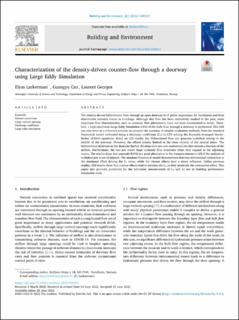| dc.contributor.author | Larkermani, Elyas | |
| dc.contributor.author | Cao, Guangyu | |
| dc.contributor.author | Georges, Laurent | |
| dc.date.accessioned | 2023-01-23T10:11:08Z | |
| dc.date.available | 2023-01-23T10:11:08Z | |
| dc.date.created | 2022-07-11T05:25:05Z | |
| dc.date.issued | 2022 | |
| dc.identifier.citation | Building and Environment. 2022, 221 . | en_US |
| dc.identifier.issn | 0360-1323 | |
| dc.identifier.uri | https://hdl.handle.net/11250/3045232 | |
| dc.description.abstract | The density-driven bidirectional flow through an open doorway is of prime importance for ventilation and heat distribution between rooms in buildings. Although this flow has been extensively studied in the past, some important flow characteristics, such as unsteady flow phenomena, have not been documented in detail. Therefore, a high-resolution Large Eddy Simulation (LES) of the bulk flow through a doorway is performed. This LES can also serve as a reference solution to compare the accuracy of simpler evaluation methods, from the standard theoretical model calibrated using a discharge coefficient (
) to CFD solving the Reynolds-Averaged Navier-Stokes (RANS) equations. Based on LES results, the bidirectional flow can generate turbulent mixing in the middle of the doorway. However, the effects remain limited to the close vicinity of the neutral plane. The bidirectional airstream in the doorway further develops into two non-isothermal jets that entrain a fraction of the airflow. Furthermore, the two jets create large unsteady flow structures when they expand in the adjoining rooms. The results show that unsteady RANS is a good alternative to the resource-intensive LES if the analysis of turbulent jets is not of interest. The standard theoretical model demonstrates that two-dimensional contraction is the dominant effect driving the
value, while the viscous effects have a minor influence. Unlike previous studies, LES results show that viscous effects tend to increase the
as they moderate the contraction effect. This paper also provides guidelines for the laboratory measurement of
and its use in building performance simulation tools. | en_US |
| dc.language.iso | eng | en_US |
| dc.publisher | Elsevier | en_US |
| dc.rights | Navngivelse 4.0 Internasjonal | * |
| dc.rights.uri | http://creativecommons.org/licenses/by/4.0/deed.no | * |
| dc.title | Characterization of the density-driven counter-flow through a doorway using Large Eddy Simulation | en_US |
| dc.title.alternative | Characterization of the density-driven counter-flow through a doorway using Large Eddy Simulation | en_US |
| dc.type | Peer reviewed | en_US |
| dc.type | Journal article | en_US |
| dc.description.version | publishedVersion | en_US |
| dc.source.pagenumber | 16 | en_US |
| dc.source.volume | 221 | en_US |
| dc.source.journal | Building and Environment | en_US |
| dc.identifier.doi | 10.1016/j.buildenv.2022.109319 | |
| dc.identifier.cristin | 2037898 | |
| dc.relation.project | Sigma2: 70442683 | en_US |
| cristin.ispublished | true | |
| cristin.fulltext | original | |
| cristin.qualitycode | 2 | |

